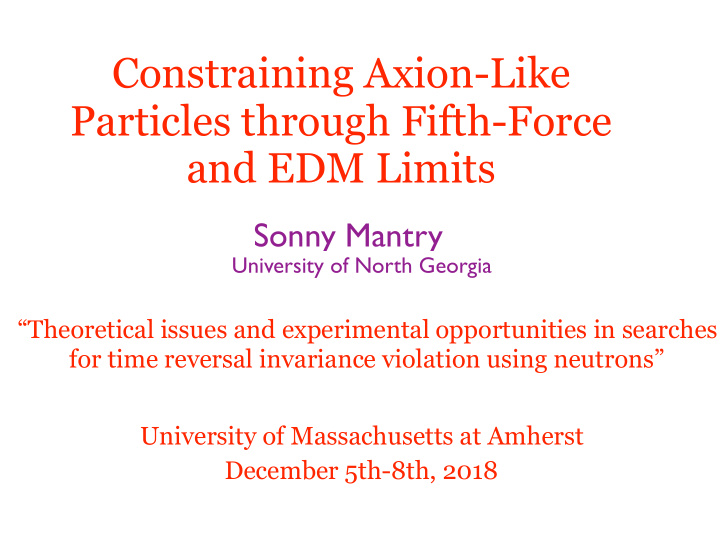



Constraining Axion-Like Particles through Fifth-Force and EDM Limits Sonny Mantry University of North Georgia “Theoretical issues and experimental opportunities in searches for time reversal invariance violation using neutrons” University of Massachusetts at Amherst December 5th-8th, 2018
Constraining Axion-Like Particles n i γ 5 g p m ϕ mirror g s
Macroscopic Spin-dependent Forces
Short Range Macroscopic Scalar Forces 30 NEW MACROSCOPlC FORCES? 131 (Moody, Wilczek) couple to quarks a T-conserving pseudosca- only through lar vertex: 1759p 7sg~p 1759p mq ql p5q Q where F is the scale of Peccei-Quinn breaking. symmetry (0) (c) (b) transformation a pure Peccei-Quinn changes Monopole-Monopole Monopole-Dipole Dipole-Dipole However, the 't Hooft vertex. It is energeti- FIG. 1. Graphs for the potentials of Eqs. (4), (5), and (6). (a) the phase multiplying • New short range macroscopic forces beyond the SM? to change this phase (which requires en- cally unfavorable (Monopole), (b) monopole-dipole, (c) (dipole). rom neutron Qbo ergies of the order of the mass of the g'), so the Peccei- ∼ 2 × 10 − 5 m, ∼ 10 − 2 eV. ge λ > o m ϕ < for by a combined is compensated transformation Quinn ∼ 10 − 6 eV ∼ 2 × 10 − 1 m o m ϕ > e λ < chiral U(1) and chiral SU(N) transformation which leaves a Cavendish to test et a/. experiment Spero performed Since the the energy. the phase invariant and minimizes 1/r potential over the dis- from the Newtonian deviations (Peccei- are not zero, these combined masses quark 2 to 5 cm. Their experiment tance range established an [U(1)q ] [SU(X)~ j transformations cost energy, Quinn) for interactions additional Yukawa-type bound upper If, in addition, and the axion acquires a small mass. the given by effective 8 parameter Hcff is not zero, the axion will also V(r) =- 6m ~m2 (1+ac ' ); — couple to the quarks with scalar vertices. T-violating r/A. r To see how this all works, consider the quark-mass and A, -3 cm, a was found T-violating sectors, at their scale of greatest sensitivity H „, . Since the dimensionless 10 to be less than coupling +H. c. =m„ut ug+mgdLdg+ (7a) two nu- constant for the gravitational interaction between cleons is (mz/mp~) =10, we see that any anomalous arid of 10 ' or smaller. at a scale of 3 cm must have a dimen- Yukawa coupling 2 — HT — GG . 0 (7b) sional magnitude 32m2 g factor of the electron provides a limit The measured interactions. Under a Peccei-Quinn transformation, electron on nonelectromagnetic spin-spin agree with the predictions Since the experimental findings — ql. ~e i g/2 i g/2 mq~mqe, qL, , qR~e qg, of QED to eight digits for experiments ferromag- using nets, we get a limit for any nonelectromagnetic the phase of the 't Hooft vertex varies as spin-spin Xa(A, , /1 a scale of 1 cm of 10 cm) at coupling r arg g k, gg =10 ', where A, , is the electron Cornpton wavelength and cx: 1 q A limit on photon tensor interactions is pro- spin-spin becomes e' + "', where N = number of quark hence, e' of the based studies hydrogen vided by Ramsey, upon under chiral U(1), flavors. Similarly, interac- that finds molecule. nonmagnetic Ramsey any be 4&10 " smaller that tion must than between proton to a distance of 1 cm, Extrapolated moments. magnetic cou- limit on the dimensionless this establishes an upper tensor force of 10 as e'e~e'e+ '. Thus, a pling for an r and the 't Hooft vertex changes limit of 10 ' Of these (mono- the anomalous various limits, only by Spero et al. chiral U(1) transformation Peccei-Quinn interaction obtained combined and pole) with v= — the range of possible q leaves 0 invariant. for comes close to testing strengths we know of no obvi- the mass of the axion, To calculate forces. we imagine per- axion-mediated Furthermore, P- and T- the a Peccei-Quinn transformation; this on the macroscopic leaves forming ous experimental limit 0 to 0+60. interaction. Thus, the oppor- terms but changes monopole-dipole mass unchanged, violating quark b, 8 into the We now undo this change of 0 by reabsorbing is ripe for pushing and perhaps past known limits tunity chiral SU(N))&U(1) We shall shortly discuss some ex- mass sector by the combined new. quark finding something This gives which may do so. the energy. transformation which minimizes periments H „= m„uu cosh'„+ m~dd coshO~+ . AXIONS (10) 40„+ 40~+ 48, +. . . = 60. for a very light A particularly well-motivated proposal to the constraint subject It arises in models to explain spin-0 boson is the axion. acquire the vacuum expectation Since the quark bilinears P- and of a potentially the T-violating smallness large . value (uu)=(dd)= =V&0, the minimum is found in QCD. coupling to be at boson of a The axion is the quasi-Nambu-Goldstone If Peccei-Quinn broken quasisymmetry. spontaneously not broken the the Peccei-Quinn were symmetry by i&q t Hooft in in- associated fermion vertex with emission mj the axion and stanton fields, be massless would would
Recommend
More recommend